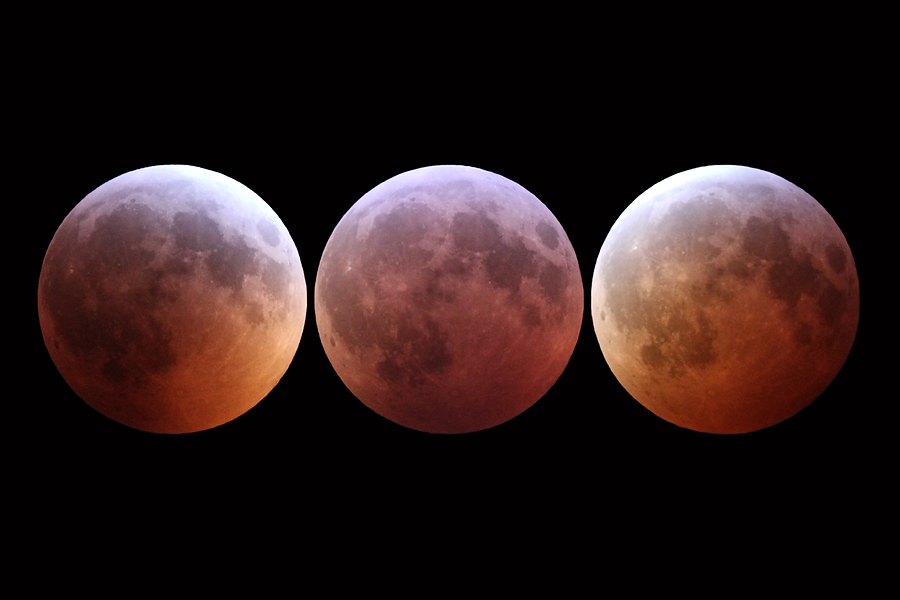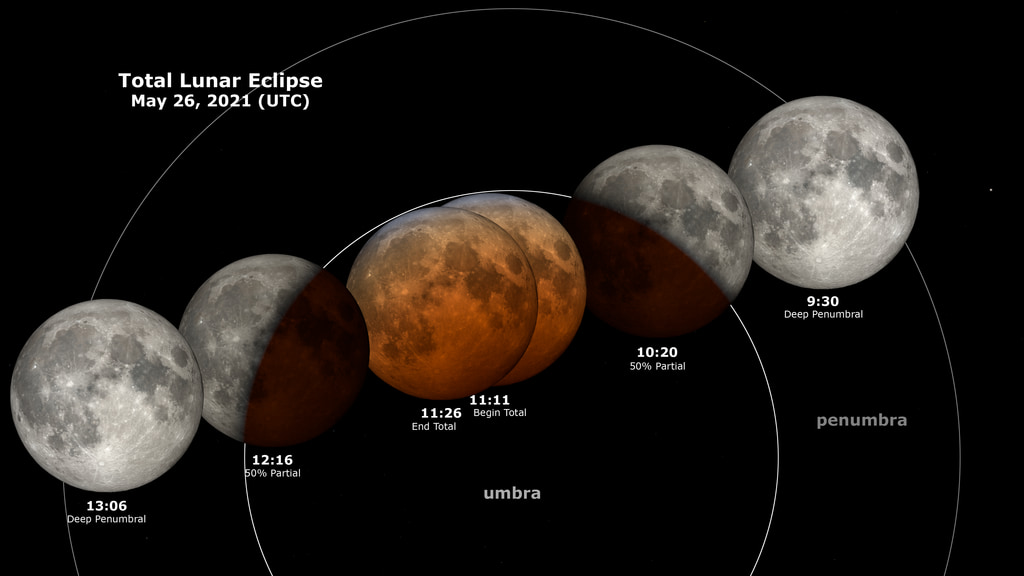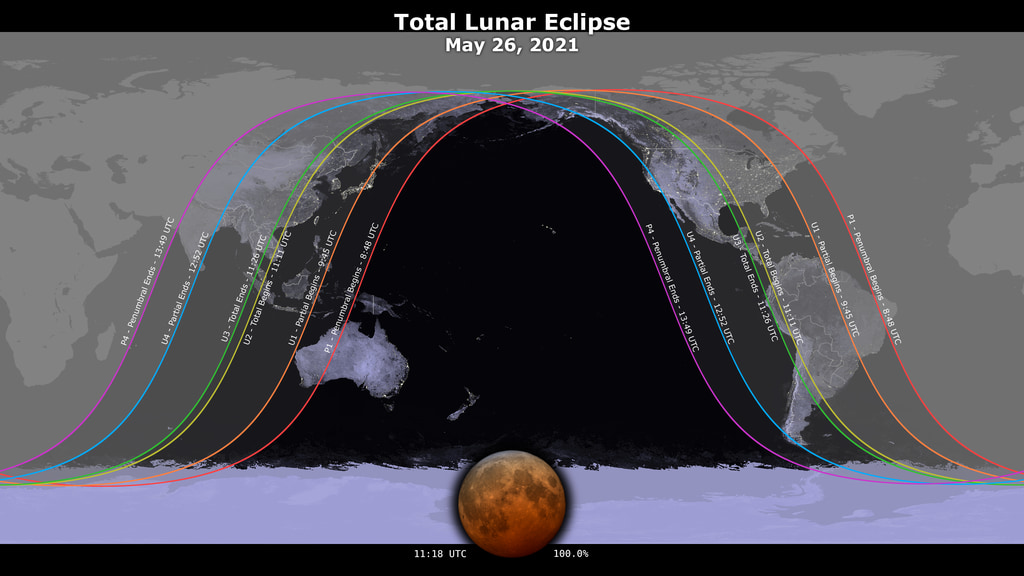Teach your kids about the Super Flower Blood Moon lunar eclipse of 2021
It's the only total lunar eclipse of the year!
The only total lunar eclipse of 2021 occurs this week and for families looking to enjoy the "Super Flower Blood Moon" eclipse, here's everything you need to know.
On May 26 (or between May 25-27, depending on where you are in the world) there will be a total lunar eclipse. During a lunar eclipse, the moon travels through Earth's shadow as our planet is directly in between the sun and our natural, rocky satellite. In a total lunar eclipse, the moon and sun are on exact opposite sides of the Earth and the moon is completely engulfed in Earth's shadow, while a partial lunar eclipse occurs when only a part of the moon moves into Earth's shadow.
This eclipse will occur at the same time as a "supermoon," an informal term that describes times when the full moon is at perigee, or its closest point to Earth, making it look extra big and bright in the night sky.
Depending on where you live, you will need to wake up early or stay up late to see the eclipse. It begins at 4:47 a.m. EDT (0847 GMT), with peak totality occurring at 7:16 a.m. EDT (1116 GMT). The eclipse will end at 9:50 a.m. EDT (1350 GMT). If it is daytime in your viewing location, you will have to watch webcasts where it is still night.
'Super Flower Blood Moon' webcasts: How to watch the lunar eclipse online

If you take a photo of the 2021 total lunar eclipse let us know! You can send images and comments to spacephotos@space.com.
The upcoming eclipse will be visible from western North America, southern and far-western South America, the Pacific Ocean, New Zealand, Australia and southeast Asia.
Totality, or the point when Earth's shadow is fully obscuring the moon, can last anywhere from a few seconds to up to 100 minutes. The totality of this upcoming eclipse is expected to last for about 14 minutes and 30 seconds. However, for those who will be able to view the total lunar eclipse, get outside early because, starting about an hour and a half before totality you will be able to see a "partial umbral eclipse." This means that you will slowly start to see the shadow cast across the moon's face.
According to NASA, whether you catch just part of the eclipse or witness the entire event, viewing a lunar eclipse is "an awe-inspiring sight that gives students a great opportunity to engage in practical sky watching." The education team at NASA's Jet Propulsion Laboratory has this awesome lunar eclipse activity for kids to teach students how and why lunar eclipses work.
Breaking space news, the latest updates on rocket launches, skywatching events and more!
Aside from acting as an opportunity for learning, it's also just "a really fun experience to go and look at a total lunar eclipse," astronomer and astrophysicist Jackie Faherty of the American Museum of Natural History in New York City told Space.com.
Tips and tricks for watching a lunar eclipse
To get started, the three best tools you can have to watch a lunar eclipse are a comfortable place to sit, snacks and — most of all — patience, Faherty said.
While totality for this eclipse will last for less than 15 minutes, there is so much more to see during the night of this total lunar eclipse.
Instead of trying to time it so that you just run outside to catch a quick glimpse of the eclipse then run back in, Faherty instead suggests that, even if your region is only experiencing a partial eclipse, you should still plan to skywatch and enjoy more than just the eclipse itself.
"Think of it more like you would a Netflix movie or a show," Faherty said. "Get yourself ready in that same way."
"Get some popcorn, a glass of something good," she added. "Get yourself a little cozy seat so that you can see a nice clear view of the moon. Get there before it goes into the maximum stage where it's in the darkest part of the eclipse so that you're seated, you're ready and just kind of watch it unfold."
The nighttime sky is the original movie theater. It was the original entertainment zone for people. Make up stories to describe shapes and patterns you see in the stars, make up stories of what the moon is doing. Get comfortable, get cozy, and then stick it out for a while. Let yourself really take it in."
Related: How the night sky constellations got their names
Besides just the fun of watching the eclipse itself, by getting comfortable and hanging out a while, you can turn an eclipse-watching event into a more exciting skywatching event. Because the moon is dimmer than usual as Earth's shadow passes across it, the reduced glare from the moon actually makes the sky darker, and stars become more visible.
Faherty likened the moon to a bright flashlight in a dark place; when you're using a flashlight you can see what it's shining on but it makes it harder to see the dark areas where you're not pointing it. In other words, The bright light from a full moon will wash out the stars around it. Now, it's easier to see the stars when there is a new moon (and you can't see the moon in the night sky), but when there is a bright, full moon it can be very difficult to see the stars. That's why it's so special that, during the eclipse, you will be able to view both a full moon and the beauty of the night sky's stars all at once.
"Take it in, take the night sky in. Don't just think of it as a lunar eclipse viewing thing, take it in as a skywatching thing," Faherty said.
Spending the evening out watching the sky instead of just jumping out to see the eclipse will also give your eyes more time to adjust, she added. "It takes a while for your eyes to adjust. It takes a while for your eyes to get dark adjusted. And for you to really pay attention to what's there. The longer you stare at the sky, the more you see," Faherty said.
What will you see?
It's difficult to predict exactly what the eclipse will look like, but it's possible that it will actually look red!
Lunar eclipses are often brownish or even reddish colors because the sunlight that usually just bounces right off of the moon will first go through Earth's atmosphere. In general, Earth's atmosphere actually filters out shorter-wavelength blue light so all that's left is reddish and orange light. Also, different particles in our atmosphere can add to this weird, color-changing effect.
For example, Faherty said, "if there are a lot of volcanic eruptions ... that are going on on the planet that toss a lot of material into the upper atmosphere, that can create some gorgeous colors," she said.
Faherty compared the "blood moon" phenomenon to watching a sunset or sunrise, whose vibrant colors are affected by what's in Earth's atmosphere, so you can't predict exactly what they will look like on a given night. Your view can also be affected by clouds and bad weather.
Related: Just how 'bloody' will the Super Flower Blood Moon eclipse look?
Helpful info for skywatching
To have a better idea of exactly when the eclipse will be happening, where you are and how much of the eclipse you might be able to see, you can check out this eclipse map from Time and Date.
If you're in the Americas, you will be able to spot the eclipse in the hours before sunrise on May 26 and from the Eastern hemisphere, you will be able to spot it after sunset on May 26.
The total eclipse will be visible near moonset in the western continental U.S., Canada, Mexico, most of Central America and a few additional countries, while it will be visible just after moonrise along the asian pacific rim.
For example, if you live in Seattle the moon will set at about 5:29 a.m. local time (8:29 EST (1229 GMT) on May 26 so you'll have to get up early in the morning to catch it; whereas in Tokyo, Japan along the Asian Pacific rim moonrise will be at 6:37 p.m. local time (5:37 a.m. EST (0937 GMT)) so you'll be able to spot the eclipse in the evening, according to timeanddate.com.
The partial eclipse, when the moon is partially covered by Earth's dark, inner shadow before and after totality, will be visible from Canada and the eastern U.S. just before the moon sets and from India, Nepal, western China, Mongolia and eastern Russia just after the moon rises. Skywatchers in eastern Australia, New Zealand and the Pacific islands will see both the total and partial eclipse.
Email Chelsea Gohd at cgohd@space.com or follow her on Twitter @chelsea_gohd. Follow us on Twitter @Spacedotcom and on Facebook.

Chelsea “Foxanne” Gohd joined Space.com in 2018 and is now a Senior Writer, writing about everything from climate change to planetary science and human spaceflight in both articles and on-camera in videos. With a degree in Public Health and biological sciences, Chelsea has written and worked for institutions including the American Museum of Natural History, Scientific American, Discover Magazine Blog, Astronomy Magazine and Live Science. When not writing, editing or filming something space-y, Chelsea "Foxanne" Gohd is writing music and performing as Foxanne, even launching a song to space in 2021 with Inspiration4. You can follow her on Twitter @chelsea_gohd and @foxannemusic.


